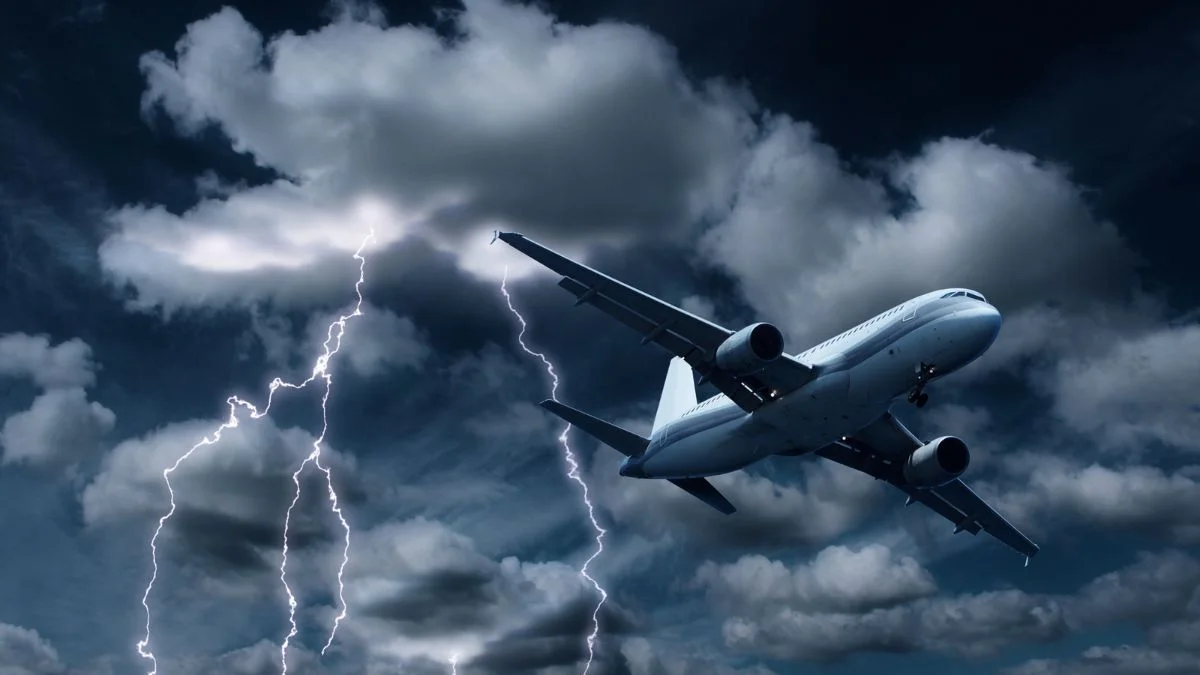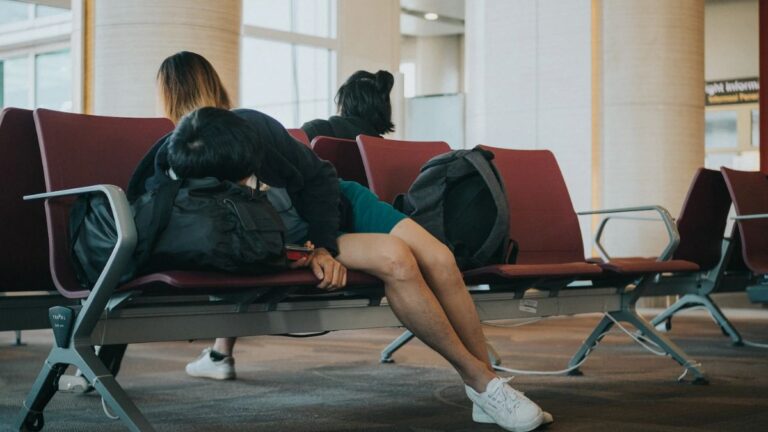What Are The Most Turbulent Months To Fly? Statistics Revealed

As participants in Amazon Associates and other programs, we earn from qualifying purchases. This comes at no additional cost to you. For more details, see our Affiliate Disclosure.
For many travelers, turbulence is a significant cause of anxiety when flying. As our planet’s atmosphere churns and flows, it’s only natural that aircraft experience these air pockets. But did you know that certain months of the year statistically witness more turbulence than others? Dive in to understand what causes this, when it’s most likely to occur, and tips to make your journey smoother.
HIGHLIGHTS
- The summer months of June, July, and August in the Northern Hemisphere, as well as the winter season over regions like Japan, are more prone to turbulence.
- Routes like New York to London often experience turbulence due to the jet stream, and flying over large water bodies or flat lands typically results in smoother flights.
- Only about 0.0001% of flights worldwide encounter severe turbulence, with extreme turbulence being even rarer.
- From 2009 to 2021, out of the millions who flew, 30 passengers and 116 crew members were seriously injured because of turbulence, as reported by the FAA.
Understanding Turbulence: Types and Causes
Turbulence is a phenomenon most air travelers are familiar with, yet it remains one of the most misunderstood aspects of flying. At its core, turbulence is simply the irregular motion of air, often caused by various natural factors that affect the atmosphere. But not all turbulence is created equal. Let’s delve deeper into the different types of turbulence and the primary causes behind each.
Types of Turbulence
Light Turbulence: This is the most common type and is usually characterized by slight, unexpected shifts in an airplane’s altitude. It’s more of a minor annoyance than a safety concern and can feel like a car going over a bumpy road.
Moderate Turbulence: This form of turbulence can be a bit more unsettling. It causes rapid jumps or jolts in an airplane. Statistically speaking, moderate turbulence is encountered in only between one to five per cent of all flights worldwide.
Severe Turbulence: Far rarer than the previous two types, severe turbulence can be intense enough to toss unsecured items (and even unbelted passengers) within the cabin. It occurs in about 0.0001 per cent of flights worldwide. It’s this type of turbulence that underlines the importance of always having your seatbelt fastened when seated.
Extreme Turbulence: The rarest of them all. Extreme turbulence has the capability to cause significant aircraft damage and poses a serious safety threat. In fact, only one recorded plane crash, a BOAC flight in 1966, is associated with this type of turbulence. It is said that the aircraft encountered extreme turbulence after taking off from Tokyo Airport, crashing into Mount Fuji.
Causes Behind Turbulence
Turbulence can be triggered by a multitude of atmospheric and human-made conditions:
Jet Streams: These high-altitude air currents, especially over the North Atlantic, can cause turbulence due to their intense wind speeds.
Mountain Waves: When airflow encounters tall mountain ranges, it can be forced upwards, creating wave-like patterns in the atmosphere that can cause turbulence.
Thermal Turbulence: This is caused by hot rising air, usually during the daytime over flat terrains. For instance, the heat can create convection air movements, leading to turbulence.
Wake Vortex: This is turbulence created by the passage of another aircraft, especially if flying close behind a larger plane.
Weather Fronts: The meeting point of two differing air masses can lead to turbulence. A notable example is the equatorial region, where northern hemisphere winds confluence with those from the southern hemisphere.
By understanding the various types and causes of turbulence, travelers can be better prepared mentally for their journey. Knowledge diminishes fear, and while turbulence might be a common part of flying, serious incidents, as mentioned from the Federal Aviation Administration data and the University of Reading’s research, are statistically rare. So, while those occasional bumps might be uncomfortable, they are typically no cause for alarm.
The Science Behind Flight Turbulence
Flight turbulence is a common, often misunderstood experience for many air travelers. At its most basic definition, turbulence is the irregular motion of air, triggered by various atmospheric conditions. When an aircraft moves through these pockets of unstable air, passengers feel it as the shaking or jostling familiarly known as turbulence.
Several natural factors can cause turbulence. One of the main contributors is the jet stream, a high-altitude, fast-moving ribbon of air that can cause rapid changes in wind speed and direction. Mountainous regions can also induce turbulence when air flows over them, creating wave-like patterns in the atmosphere known as mountain waves.
Additionally, hot, rising air over flat terrains during the daytime can lead to thermal turbulence. The confluence of opposing air masses, particularly near the equator, can also lead to turbulent conditions.
Furthermore, human-made factors play a role. For instance, the turbulence felt when one aircraft follows another too closely is due to the wake vortex created by the leading plane.
Though turbulence can be unsettling, it’s important to remember that modern aircraft are designed to handle these atmospheric disturbances. Severe incidents, as backed by research from the Federal Aviation Administration and the University of Reading, remain extremely rare. While turbulence is a natural part of flying, understanding its causes can help travelers feel more at ease during their journeys.
The Most Turbulent Routes
Certain air routes are notoriously known for their turbulence, primarily due to their geographical positioning and atmospheric factors. Here are some of the most turbulent routes, backed by flight records and research:
- New York to London: A popular route for many, this journey often encounters turbulence because of its proximity to the jet stream. The jet stream’s disruptive force is a primary concern, with pilots sometimes opting to navigate around it, leading to longer flight times. Airlines frequently flying this route include Air France, Delta, United, Austrian, and Norwegian.
- Seoul to Dallas: This route, especially when flown over Japan during winter, is known for its turbulence. Japan’s winter windstorms are the main culprit, causing severe disturbances in the air. Before embarking on this journey, checking weather forecasts can be beneficial. Prominent airlines on this route are Korean Air, American, and Delta.
- Flying into Certain Equatorial Airports: Airports situated close to the equator often experience frequent thunderstorms, making the descent and ascent more turbulent. Some of these airports include Bangkok Suvarnabhumi Airport (BKK), Cancun International Airport (CUN), Hong Kong International Airport (HKG), Miami International Airport (MIA), Mumbai Chhatrapati Shivaji International Airport (BOM), and Singapore Changi Airport (SIN).
- Reno, Nevada: Flights arriving and departing from the Reno-Tahoe International Airport (RNO) frequently experience short-duration turbulence. This can be attributed to a permanent patch of rough air encountered during takeoff or landing. JetBlue, Delta, American Airlines, and Volaris are some airlines that service this airport.
- London to South Africa: A multi-faceted turbulent route, flights from London to South Africa face challenges like the high mountains of the Alps and crossing the equator, which leads to changing winds and resultant turbulence. Airlines servicing this route are Etihad Airways, Turkish Airlines, Ethiopian Air, and SWISS.
While these routes are recognized for their turbulent nature, it’s essential to remember that serious injuries from turbulence remain rare. From 2009 to 2021, there were only 30 passengers and 116 crew members seriously injured, as indicated by Federal Aviation Administration data. Safety precautions, like wearing seatbelts, can reduce the potential risks associated with turbulence.
Airports Near the Equator: A Special Mention
Airports situated near the equator have a unique set of challenges and phenomena that distinguish them from others worldwide. The equator, a line that circles the globe at its widest point, brings together winds from the northern and southern hemispheres. This confluence point often experiences turbulence due to the meeting of these contrasting winds. Further exacerbating this is the equatorial region’s innate hot climate, which leads to frequent and potent thunderstorms, increasing the likelihood of turbulent air.
Among the many airports close to this turbulent equatorial belt, a few notable ones include:
- Bangkok Suvarnabhumi Airport (BKK): As one of Asia’s busiest airports, BKK witnesses a high volume of air traffic and occasionally endures the impacts of equatorial weather disturbances.
- Cancun International Airport (CUN): A major gateway to the Caribbean, Cancun occasionally faces turbulent storms, especially during the region’s hurricane season.
- Hong Kong International Airport (HKG): While not directly on the equator, its proximity leads to frequent thunderstorms, especially during the monsoon season.
- Miami International Airport (MIA): Situated in the subtropical zone, MIA sees its fair share of thunderstorms, often intensified by the warm waters of the Gulf Stream nearby.
- Mumbai Chhatrapati Shivaji International Airport (BOM): Mumbai’s monsoon season can be particularly severe, influenced by its coastal location and proximity to the equator.
- Singapore Changi Airport (SIN): Renowned for its efficiency and as a global hub, Changi too isn’t spared from the equatorial climate’s challenges, facing thunderstorms especially during the inter-monsoon periods.
For travelers, the equatorial turbulence may sound intimidating. However, modern aviation technology and well-trained pilots ensure that flights remain as smooth as possible, even when navigating the stormy equatorial skies.
Safety measures, routine weather updates, and course alterations are frequently employed to provide passengers with a comfortable journey. Always remember that while turbulence might be an inconvenience, safety in aviation remains paramount.
Statistical Data on Turbulence-Related Incidents
When we think about flight safety, turbulence often comes to mind as a primary concern for many passengers. However, examining statistical data on turbulence-related incidents can provide some reassurance and perspective on the actual risks.
Frequency of Turbulence
Turbulence is a common occurrence during flights. At flight cruising levels, about 3% of the atmosphere experiences light turbulence.
Only about 1% has moderate turbulence, which can cause jolts but is typically manageable for pilots and passengers. Severe turbulence, which can pose a risk of injury if passengers are not belted, is exceedingly rare, occurring in only a few tenths of a percent of the atmosphere at any given moment.
The chances of encountering severe turbulence are further reduced thanks to advanced forecasting tools and pilot experience.
Injury Rates
Between 2009 and 2021, out of the millions of people who fly annually, 30 passengers and 116 crew members were seriously injured due to turbulence, according to the Federal Aviation Administration (FAA) data.
It’s essential to understand the FAA’s definition of ‘serious injuries,’ which includes those that require over 48 hours of hospitalization, fractured bones, significant muscle or tendon injuries, internal organ damage, or second- or third-degree burns.
It’s worth noting that airlines are not mandated to report more minor injuries, which means the total injury count is likely underreported.
Safety Measures
The National Transportation Safety Board (NTSB) has highlighted the importance of wearing seat belts during flights. Their 2021 report indicates that a significant portion of passengers injured by turbulence weren’t wearing their seatbelts.
These injuries often occurred while passengers were using the restroom or walking in the aisle. The same was true for cabin crew members, most of whom were injured during cabin service or while preparing the cabin for landing.
Cost Implications for Airlines
Turbulence isn’t just about safety; it also has financial implications for airlines. Approximately 65,000 flights experience moderate turbulence each year, with about 5,500 encountering severe turbulence.
These events can lead to delays, injuries, and damage to the aircraft’s cabin components. The combined cost of these incidents, including repairs, medical treatment, and other related expenses, is estimated to be up to $500 million per year.
Rare Fatalities
Deaths related to turbulence remain extremely rare. For instance, the NTSB is still investigating a recent case where a passenger on a business jet flying from New Hampshire to Virginia lost their life. However, such incidents are isolated and highly uncommon.
Turbulence Impact on Airlines and Aircrafts
The term “turbulence” often evokes a sense of unease among airline passengers. However, beyond the passenger experience, turbulence also presents operational, financial, and maintenance challenges to airlines and aircrafts. Understanding its multifaceted impact offers a comprehensive view of the concerns and the measures taken to address them.
Operational Challenges
Flight crews, particularly pilots, must be adept at predicting, identifying, and navigating through areas of turbulence. This often involves communicating with air traffic control to change altitudes or slightly adjust routes to avoid rough patches.
While advanced equipment and training enable pilots to manage these situations expertly, it can occasionally lead to delays and deviations from the planned route.
Financial Implications
Turbulence isn’t just a matter of comfort or safety; it has clear economic ramifications for airlines. Each year, turbulence-related events – which include passenger and crew injuries, cabin damage, and resultant flight delays or cancellations – cost airlines up to $500 million.
These expenses come in various forms: medical treatment for injured passengers or crew, repairs to cabin interiors due to wear and tear or more sudden damage, and compensation to passengers for delays or inconveniences.
Maintenance and Repairs
Aircrafts sometimes suffer from wear and tear due to regular encounters with turbulence. While the structural integrity of modern aircrafts is designed to withstand turbulence’s forces, repeated jostling can cause minor damages.
Overhead bins may malfunction if luggage is dislodged during severe turbulence, or seats might suffer from the repeated stress. More severe turbulence can also warrant thorough inspections of the aircraft to ensure no critical components were compromised.
Passenger Confidence and Brand Image
Regular incidents of severe turbulence, even if managed safely by the crew, can impact an airline’s reputation. Passengers may opt for competitors if they perceive a particular airline or route to be more prone to turbulent flights.
Maintaining passenger confidence is crucial for airlines, and transparent communication about turbulence and safety measures can help in this regard.
Crew Safety and Training
Flight attendants are more likely to be injured by turbulence than passengers, primarily because their duties require them to be up and about more frequently.
This underscores the importance of comprehensive training for flight crews to handle turbulence-related scenarios, ensuring their safety and the well-being of passengers.
Traveling Safely: Tips and Precautions
For many, the mere thought of turbulence can spark unease or even fear. Yet, flying remains one of the safest modes of transportation, and there are measures passengers can take to enhance their comfort and security. Knowledge, preparation, and adopting certain habits can make your flying experience smoother and alleviate concerns about turbulence.
- Stay Informed: Before your trip, research the usual turbulence patterns for your specific route, keeping in mind that certain paths, like New York to London or flights near the equator, might experience more turbulence due to geographical or atmospheric conditions.
- Choose Optimal Flight Times: Some evidence suggests that early morning or nighttime flights tend to experience less turbulence. This is attributed to decreased wind speeds and the reduction of thermally-induced turbulence caused by the sun heating the Earth’s surface.
- Seat Selection: Seats located over the wings, in the aircraft’s center, generally experience less motion during turbulence compared to those in the front or rear.
- Always Buckle Up: Even when the seatbelt sign is off, it’s a good practice to keep your seatbelt fastened. The National Transportation Safety Board (NTSB) report highlighted that the majority of passengers injured due to turbulence weren’t wearing their seatbelts.
- Listen to the Crew: Flight attendants and pilots are trained to handle turbulence. Heed their advice, especially when they ask you to return to your seat and fasten your seatbelt.
- Stow Away Loose Items: Ensure your belongings, especially heavier ones, are securely stowed in the overhead bins or under the seat in front of you. Loose objects can become projectiles during severe turbulence.
- Limit Movement During Expected Turbulence: If you’re aware that you’ll be flying through an area known for turbulence, try to minimize your movement around the cabin. Use the restroom or stretch before reaching these zones.
- Stay Calm and Relaxed: While turbulence can feel unsettling, remember that aircraft are designed to handle it. Tightening up or bracing against the seat can make you feel each bump more acutely. Instead, take deep breaths and try to relax your muscles.
- Distraction: If turbulence makes you nervous, use headphones to listen to calming music, watch a movie, or dive into a captivating book. Sometimes, distracting your mind can make the time pass more comfortably.
- Educate Yourself: Understanding that only about 1% of the atmosphere has moderate turbulence and even a smaller fraction has severe turbulence can provide some peace of mind. Furthermore, technology and pilot training have evolved to predict and manage turbulence more effectively.
While turbulence can be uncomfortable, serious injuries related to it are rare. By taking these precautions and staying informed, you can ensure that your journey in the skies is as smooth and safe as possible.
Which Months to Watch Out For?
Turbulence, while often unexpected, tends to have seasonal patterns, largely due to atmospheric changes and weather disturbances. Generally, summer months, particularly June, July, and August, are known for a higher occurrence of turbulence in the Northern Hemisphere. This is attributed to the presence of thunderstorms and convective currents caused by the warming earth.
Conversely, the winter months can also present challenges. Flying over regions like Japan in the winter season can be particularly turbulent due to the cold fronts and windstorms that frequent the area.
For those traveling across equatorial regions, it’s important to note that the equator can be turbulent throughout the year. The meeting of the northern and southern hemisphere winds, combined with frequent thunderstorms, makes areas close to the equator a hotspot for air disturbances.
Lastly, the jet streams, which are predominantly active over the North Atlantic and influence routes like New York to London, are most pronounced during the transition between seasons, specifically during the spring and fall.
In essence, while each season carries its own set of turbulence-related factors, being informed about your specific route and the current weather conditions can help you anticipate and prepare for a smoother flight.






